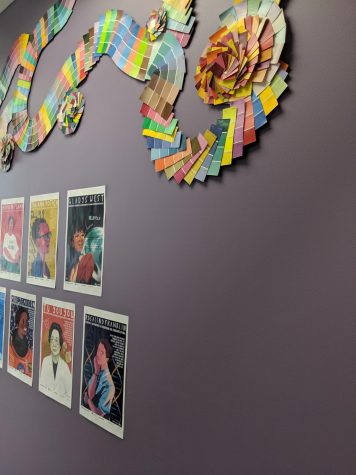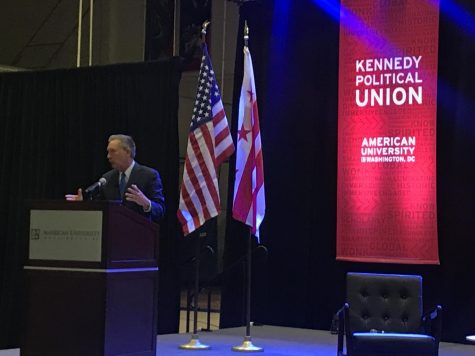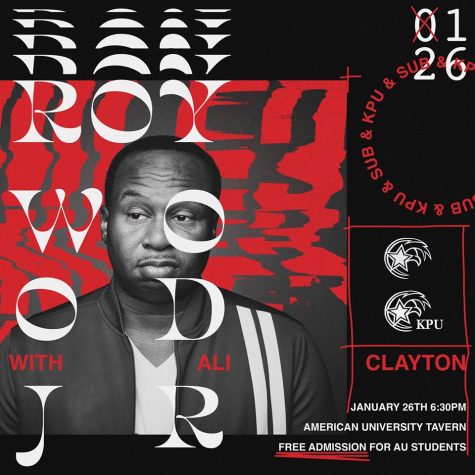Diplomacy Blossoms: The Secret History of DC's Favorite Tree
It is late March in Washington, already a day into the world’s most popular tree blossom festival, and yet winter, like a sozzled old man in a bar, is dragging its feet out the door. Underfoot the ground gives a little, sodden with melted snow. Jinsam Choi walks behind former SIS dean Louis Goodman with caution so as not to scuff his shoes. Choi is a documentary filmmaker from the Korean Broadcasting System putting together a feature on the species Prunus yeodoensis, known to many as cherry blossoms and to less as Yoshino cherry trees. In the last few years, new evidence has shed light on where the trees originated from and Choi is hoping to document these discoveries in time for the year’s annual flowering. Accompanied by a translator and assistant, Choi follows Goodman behind the East Quad building where a small grove of aging cherry trees droops over the landscape. Choi fixes his camera on the former dean, who, standing before the old school of international service, begins to recount a story of war, beauty and science: it is the story behind the Korean cherry trees of American University.
***
April, 1943: a different crowd altogether stood alongside Nebraska Avenue. Far from the theater of the Pacific where America was fast at war with Japan, a Harvard-educated Korean politician named Syngman Rhee bent down to plant the first cherry tree on American University’s campus. AU students, faculty and Korean women in traditional hanboks gathered about him with folk music ringing in the air. As Rhee spread soil over the sapling, AU president Paul F. Douglass read from the Korean Declaration of Independence. The goal of the ceremony: to bring an end to Japan’s nearly 40-year occupation of Korea. For the white-haired Dr. Rhee, this was denouement to a lifetime spent in waiting.
A new book by scholar Young Ick Lew titled, “The Making of the First Korean President,” details Rhee’s campaign to win over American public opinion and liberate Korea from Japanese control, a feat in which American University itself played a role. Rhee, who went from political prisoner to a student at Harvard and Yale to president of the Korean provisional government in exile, worked from Washington D.C to rally political allies for his cause. One such ally was the 37 year-old president of American University, Paul Frederick Douglass, whose parents had been Christian missionaries in Korea during the 1930’s. While it is not known how the two men met, according to Lew, Rhee installed Douglass as the head of the Christian Friends of Korea (CFK), a newly-formed organization composed of religious associates and other missionaries. With the CFK, Douglass urged members to lobby their representatives for Korean independence.
By the tree planting in 1943, anti-Japanese sentiment in the United States was rampant. After the attack on Pearl Harbor two years earlier, four Tidal Basin cherry trees were cut down by vandals in suspected retaliation. All around the country, the government interned Japanese Americans in camps and soon even began referring to the Yoshinos along the Tidal Basin as “Oriental” cherry trees.
With the trees’ reputation on the wan, Rhee saw an opportunity. The cherry trees, Rhee said, were another example of the Japanese exploiting Korean resources. On the day of the planting, he claimed in his speech that the species originated in Korea, announcing to the crowd that this grove would replevin from history the original ownership of the Yoshino from Japan. They would be known as “Korean Cherry Trees.”
Though he was heard loud and clear, Syngman Rhee’s claims would go unsubstantiated for nearly 70 years.
After the war, Rhee became the first democratically elected Korean president. But for all his hopeful idealism, Rhee turned despotic. His southern regime brutally and routinely repressed the slightest inkling of communist fervor. This manifested itself tragically in 1948 on Jeju island—an ancient landscape of shrubs, trees, mountains, and waterfalls just off the south coast of the peninsula. In the early spring that year, amid the flowering of the island’s own cherry trees, an episode of police violence incited a communist uprising. Rhee’s government sent in paramilitary troops against the insurrection, and Rhee himself declared martial law on the island. A truth commission has since reported over 14,000 deaths from the rebellion. Eventually, a group of students successfully called on him to resign, and Rhee disappeared from South Korea’s political arena in 1960 at age 84. He died in 1965. Today, Rhee is remembered as a quazi-democratic dictator, best known for his stern anti-communist actions.
***
On the top shelf in Dean Goodman’s office in the new SIS building rests a porcelain bowl of light turquoise, a present from South Korean president Kim Young-sam. The gift is one of many items from the country collected over the years. No longer the dean, Goodman still teaches classes in the School of International Service, under the title “Dean Emeritus.” Years later, Goodman still remembers what first piqued his interest in the trees.
Upon his appointment to the dean of AU’s School of International Service in 1986, Goodman set himself up in an office overlooking Nebraska Avenue. Each spring, he recalls, long black limousines would pull up unannounced, and out would come groups of older Korean men. Watching from above, he saw one after another approach the blooming cherry trees and tie a thread around them in what looked like some sort of votive offering.
“I would go out and say, ‘Welcome. What are you doing here?’ And they had no idea it was American University” Goodman said. Many of these men, he learned, were original participants in the Korean independence movement there to pay homage to perhaps the most famous participant in the struggle, Syngman Rhee. The threads were a wish-making tradition in Korean culture.
“There was a knowledge in the Korean community about these trees. Korean Americans and Koreans, not just in Washington, but from New York, Philadelphia, and Los Angeles, would come here,” Goodman said.
But his full understanding of their significance was still years away.
In 2005, the Korean ambassador to the United States, Lee Tae-sik, approached Goodman at a diplomatic reception. Lee was curious about AU’s grove: was what Syngman Rhee believed about the trees’ origins true? Were they in fact Korean?
For years, the ambassador’s inquest went unanswered, but in time, the truth would bud anew. In 2009, a pair of researchers looked into the matter on their own. Dr. Eun Jeu Cheong, a Korean American working for the United States Department of Agriculture’s research division and Dr. Chan Soo Kim of the Korea Forest Research Institute took several cuttings from AU’s trees. Using the leaves’ DNA, Cheong cross-analyzed the trees with the Tidal Basin specimens. Cheong found that not only were AU’s trees the same as those along the Tidal Basin, but that both shared a genetic makeup with the wild cherries of Jeju island. Dr. Cheong confirmed what had gone unrecognized for centuries: the trees were originally from Korea. Syngman Rhee was right.
Upon hearing their findings, Goodman flew to Korea with Dr. Cheong and Dr. Kim to present the results at the Korean Foreign Research Institute’s annual conference. News of the discovery so rocked the event’s organizers that Dr. Cheong’s findings became the theme of the year’s annual conference, and the Institute even decided to hold the conference on Jeju island.
Travelling with the scientists and a prominent Korean member of the SIS faculty, Goodman was met with gratitude and plaudits. But one event from the trip still causes him to bristle. At a dinner conference where many locals from the island had come to here the team’s findings, Goodman began to tell the story with the help of a translator. When Rhee’s name entered into the speech, the audience, he said, “just went cold.” He later realized that he was speaking to the very descendents of those killed in the 1948 massacre who still harbored the resentment of unrighted wrongs.
But Goodman knew that this shared history was larger than one individual. On the last day of his trip, Goodman reached Gwaneumsa, an ancient buddhist temple at the foot of Mt. Halla mountain where the original Yoshinos have grown wildly since anyone can remember. In April’s light mist, he looked out to the the endless blossom of pink swaying in the wind.
***
The campus to which Choi and his documentary crew look out could hardly be any more different than the planting ceremony 71 years before. Today, a busy stretch of Nebraska Avenue cuts right behind the grove, and numerous buildings and offices have risen. Today, the yoshinos are dying. Each year, the campus arboretum has to remove dying limbs and trunks from the trees, a process which by now has littered their structures with stumps and scars. But still and unaltered is this exchange of stories and friendship, which take place is an air of understanding, of diplomacy. Goodman looks to Choi and his crew with a countenance befitting to the ceremony. •






